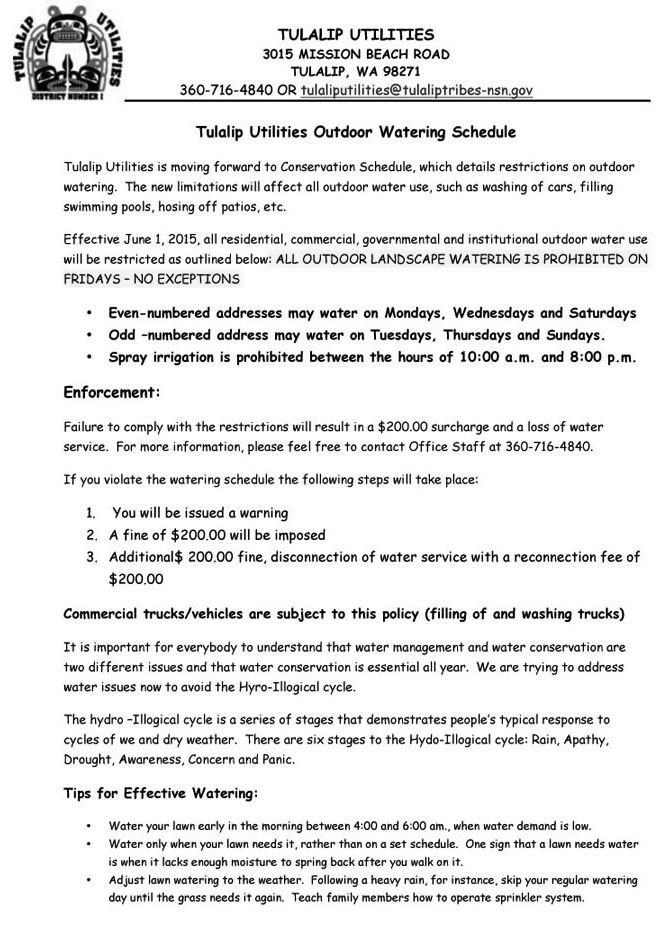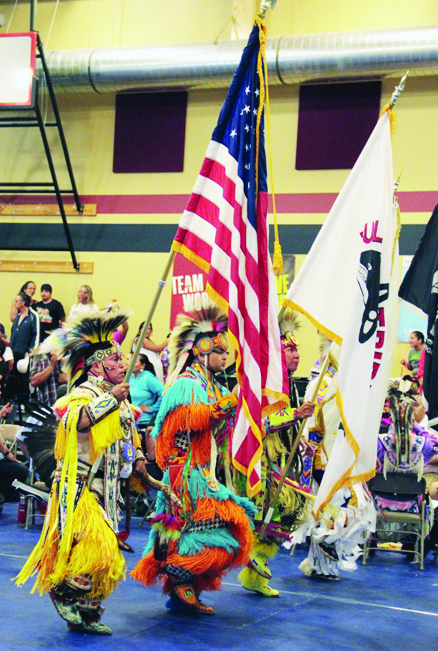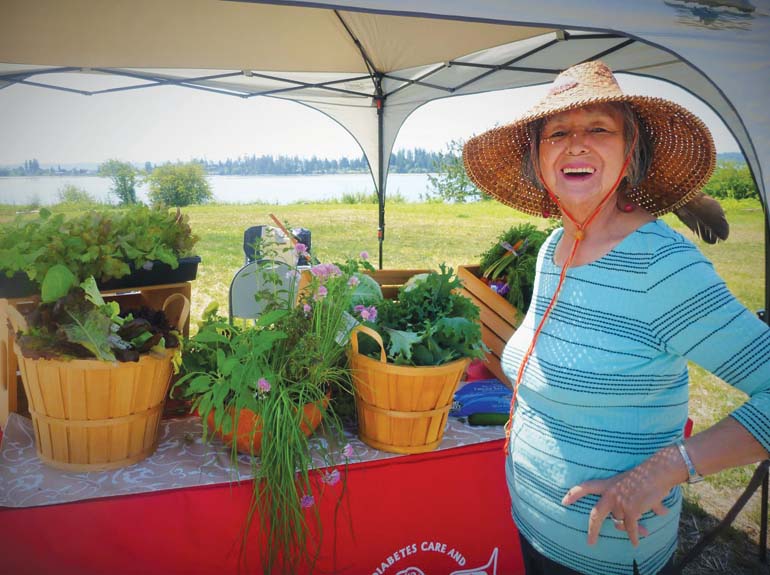These new limitations will affect all outdoor water use, such as washing of cars, filling swimming pools, hosing off patios, etc.
Category: Tulalip News
June 17, 2015 syəcəb
Hundreds attend Tulalip Veterans Pow Wow
By Mara Hill, Tulalip News
The vibrancy of color and beauty in Native American regalia and the sound of drums is enough to give you goose bumps throughout your body, and a shiver down your spine. The intensity of the drum beat matches the heartbeat of the bystanders as they watch 15 drum groups and hundreds of dancers compete in the Annual Veterans Pow Wow. The dancing, round drums, and singing can give the sensation of being in a meditative state of mind. Attendees travel long distances to be a part of this pow wow, to not only honor our veterans, but to meet and connect with other communities and tribes.
The Veterans Pow Wow was held June 5-7 in the Don Hatch Youth Center.
Contact Mara Hill, award@tulaliptribes-nsn.gov
Technology and Families: How to Stay Connected
By Maria Shane, MA, LMHC, GMHS, Tulalip Tribes Behavioral Health
Have you ever wondered how to create the right balance between the time you spend on electronics and the time you spend face-to-face with loved ones? If so, you are not alone. Today we have smart phones, computers, TVs, laptops, tablets, iPods, gaming systems, and the list goes on. There are many benefits to the technology we have available. We have access to more information now than ever before. Through technology, we can connect with loved ones who are far away. It can be enjoyable and reduce our stress to check in with others online to share our ideas, thoughts, and feelings. Sharing a good laugh can lift our spirit. Spending time on electronics can help shift our attention away from stress, worry, and pain. However, our inability to turn off our electronics can also interfere with our ability to find true connection with one another. It may mean that our families would benefit from reasonable limits on the amount of time each day we spend on electronics. The strong urge to always be checking Facebook, texting, or gaming affects everybody: adults, teens, and young children, as well as the relationships within the family or couple. If you are curious about ways to find the right balance for your family, we hope the ideas shared here will help you think about the possibilities.
Technology and Children
Some parents and grandparents wonder how much “Screen Time” a child should have each day. There is no one right answer, and each parent/family knows their children best; however, a useful guideline is between 30 minutes to 90 minutes per day, depending on age. In general, younger children should have less “Screen Time”.
When children spend too much time each day on electronic devices, there can be negative effects. The Mayo Clinic has identified some of the effects, which include: irregular sleep patterns, behavior problems, obesity, lower grades, violence, and less time for physical play. If you are concerned about the amount of video games your child plays, or the way your teen uses Facebook, you might be interested in setting some reasonable limits for your children around electronics.
Technology and Couples
A relationship may feel negatively affected by technology when a couple has not discussed some ground rules to ensure the outside world doesn’t interfere with connection and intimacy. Couples who are having problems connecting because of electronics often report the following concerns: misinterpreting messages, feeling like screen time comes before the relationship, and having difficulty communicating face to face. Couples may find it difficult to connect, even when they’re in the same room, because of the distractions from their smart phones, computers, etc. If you and your partner struggle to safeguard your time together, you may be interested in setting some boundaries around electronics. Come up with some mutually agreed ground rules to ensure the cyber world doesn’t interfere with your quality time together.
Difficult conversations are always better to have face-to-face than through text messages. It’s easier to express your anger, frustrations or hurt feelings through a text, email or facebook post. However, when emotions are running high, the likelihood of misreading a message rises sky high. According to various researchers, body language accounts for 50-70 percent of all communication. You cannot see facial expressions, body posture or hear the tone of a person’s voice through texting. Why keep that from your loved one? Arguments aren’t easy but if you put in the work to improve your communication the results will be worth it. Strengthen your communication and enrich your relationship.
Possibilities and Solutions
If you are interested in ways other families have tackled their technology struggles, here are some tips you can consider.
Talk about It. Sit down with your family or loved one and make a plan so you can prevent the virtual world from interfering with your real world. Talk honestly about the ways technology interrupts with your connection; this will help you find clarity for what changes to make.
Establish “Tech-Free Zones”. It may be difficult to keep track of the amount of time you or anyone else in your family spends on electronics each day. However, you can set limits and create “Tech-Free Zones” in the times and places when you are together. This is important for couples as well as families with children. Some families come up with an agreement that for 30 minutes while everyone eats dinner at the table, no phones, iPads, TVs, or computers are on. Or, during the car ride to school or running errands, no one uses their phone, iPod, hand held gaming system, or tablet. Instead, you have the opportunity to talk to one another. Some families have discovered a fun way to make this a “game,” for example, the first person to check their phone during dinner has to do the dishes.
Remove TVs and Computers from Bedrooms. It may be hard to remove the TV, Xbox, and computer from your child’s bedroom; however, it may help improve sleep, academic performance, and many other areas of your child’s life. Keep TVs, computers, and gaming systems in a shared space like the living room, so you can better monitor the content and time your children spend on these electronics. Couples may also benefit from an electronic-free bedroom which can increase intimacy. Try eye-gazing instead of screen-gazing, or simply use this time to check-in and talk about your day.
Settle Disagreements Face-to-Face. Just because you can reach your partner, parent, or child anywhere at any time, doesn’t mean you always should. It’s understandable that you may want to clear the air sooner rather than later, but don’t take the risk of making matters worse. [Remember, it’s too easy to misread a text or post on Facebook.] Set a time to sit down with your loved one to talk things out, this will minimize problems because you can rely on body language and tone of voice to really get your message across.
Model Healthy use of Electronics. Adults are in a good position to model, through their own behaviors, healthy use of electronic. As adults, we need to follow the “Screen Time” rules we set for our children. We can make a commitment to avoid texting or using the phone while driving. We can show our children what appropriate conversations are on Facebook. We can turn our phones off and refrain from checking our email during dinner. Our children can follow our lead.
Engage in “Screen Time” with your Child. Use your child’s favorite app or video game as a way to connect! Sit down and play a game with your child. If this seems difficult, try doing it for only 10 minutes at a time. [You can even set a timer to help you keep track.]. Allow your child to teach you the game. You will get to have some quality time with your kid, doing something they love, and, you will have the chance to assess if the game and online community is something you are comfortable with.
Limit “Screen Time” at Bedtime. Create a “No electronics at bedtime” rule. Did you know that looking at electronic screens before sleep interferes with our brain’s ability to “shut off”? Collect phones, tablets, and other electronic devices one hour before bedtime and allow your children to pick up their electronics in the morning.
Create Ways for Children to Earn “Screen Time”. Allow children to earn “Screen Time” by completing other activities such as homework, chores, and physical play. One possibility is to allow children to earn up to one hour of screen time a night for completing one hour of the other activities. For example, if your child spends 15 minutes walking the dog, 15 minutes jumping on the trampoline, and 30 minutes reading, they can earn one hour of screen time to use watching a TV show or playing a favorite video game.
The goal is to find a balance between the benefits and advantages technology brings while avoiding the pitfalls of disconnection. When use of technology causes relationship problems such as: avoidance of feelings, isolation from loved ones, or when it blocks us from having necessary but difficult face-to-face conversations, it could be time to make a change. There are many ways to set reasonable limits on the use of technology in your life. I hope the ideas shared here have gotten you thinking creatively about your options. If you have questions or are having trouble developing a game plan in your home, consider talking to a professional for additional support.
Feel free to contact us for guidance or questions. We are here to help.
Our Child & Family Mental Wellness Team serves youth 17 and younger and their families. They are located at beda?chelh at 2828 Mission Hill Rd. Tulalip, WA 98271 and can be reached at 360.716.3284.
The Adult Mental Wellness Team serves adults 18 years and older and their families. They are located at Family Services at 2821 Mission Hill Rd. Tulalip, WA 98271 and can be reached at 360.716.4400.
Notice to Tulalip Tribes Guardians
by Wendy Church, Court Director, Tulalip Tribal Court
It has always been the Tulalip Tribes position that we should protect and cultivate the best future for our children in the Tulalip Tribal community. There is now a new Juvenile and Family Code aimed towards that goal. It fosters a family-centered approach which places family as the primary source for understanding the needs and challenges of the child.
The Court would like all Guardians to be informed that pursuant to the new Code there are some changes that they need to be made aware:
beda?chelh Guardianship Team: beda?chelh has created a guardianship division which will create rules and procedures for reviewing guardianship cases no less than semi-annually for a period of three years. If any concerns are noted by the guardianship review team, the review period may be extended past three years.
Annual Guardianship Reviews: No further Annual Guardianship Reviews will be required once a guardianship is granted unless there is a change of circumstances or a request for Court review is made by the beda?chelh guardianship team. The Court and beda?chelh retain jurisdiction until the child turns 18, marries, is emancipated or adopted.
Letters of Guardianship: Except new Letters of Guardianship which will be issued by the Court beginning on June 1, 2015. These letters will no longer expire annually but will continue until the child reaches the age of 18, marries, is emancipated or adopted. It is the goal of the Court to have all new Letters issued by December 31, 2015. If you have not received new Letters and they have expired you may call the Court and ask that a Clerk issue new Letters. The Court has many new Letters to issue; please do not call for new Letters if your current Letters are still in place. We will be working diligently to get all Guardians their new Letters in a timely manner.
Moving: Guardians should notify beda?chelh, the Court and Tribal enrollment forty-five days prior to moving beyond 60 miles from the Reservation, of the new address, the reason for the move and the plan the guardian has in place for maintaining the child with his or her family and culture. If the family fails to notify beda?chelh, a hearing may be set to determine whether the child should be allowed to move with the guardian or be returned to beda?chelh. A “Notice of Moving” form can be requested from the Court should it be necessary to notify beda?chelh and the Court.
Contact information: The Court is requiring all Guardians to submit a verification of address form so that the Court will have your most up-to date information. It has always been a Guardians duty to keep the Court informed of their current contact information. Please find the ‘Address Verification” form attached. Even if you think the Court has your current information, please return the form as soon as possible so it can be placed in your file.
The Tulalip Tribes appreciates your commitment to our children by accepting the responsibilities of being a guardian. If you have specific questions regarding your duties or rights as a guardian, you should consult an attorney. If you have questions regarding the new Guardianship procedures please call the Court at (360) 716-4773 or see the new Juvenile and Family Code online at http://www.codepublishing.com/wa/Tulalip/.
Thank you again for keeping the promise we all made to the children that they would have a safe, stable, and supportive home.
Tulalip Bay Workforce Housing Program – UPDATE

By Micheal Rios, Tulalip News
In early March the See-Yaht-Sub published an article detailing to the tribal membership the plans and goals of the Tulalip Bay Workforce Housing Program that had been implemented in partnership between the Board of Directors and the Tulalip Housing and Construction department. Since its inception, there have been many opinions and questions raised both internally and externally about the practical application of a housing program of this magnitude, with its lofty, some say unrealistic, goals and expectations. We are long overdue for an update on this program’s status.
For those who are unfamiliar with the program, Tulalip Bay Workforce Housing was implemented in early 2014 as a three step process that would drastically change rural Tulalip, for the better. The first step of the process is taking back the land that has for far too long been accommodating to non-Tulalips. More specifically, the land within the 1.7 mile residential area around Tulalip Bay. Piggy-backing off the ideals that led to all the houses being demolished and removed from Mission Beach in 2013, all the non-Tulalip owned homes in the Tulalip Bay area were going to be removed in order to return the land to where it belongs, to Tulalip. As the land leases expire, one by one each non-Tulalip house would be demolished, either by the residing home owner or by the Tulalip Tribes for a fee.
The second step of the Tulalip Bay Workforce Program was to build first-rate homes complete with top of the line appliances, immaculate fenced yards, and the latest in residential housing technology (e.g. Brinks home security systems, intelligent automated thermostats). These would be beautiful homes, as evidenced by the first few that have been built already. Each featuring a multi-million dollar view overlooking stunning Tulalip Bay.
The second step also mandates that after the construction of the houses they will then be made available to Tulalip tribal members only, as either part of a home ownership program or as a rental. While most of the houses will be designated for home ownership, a fair share will be designated as rentals for those who are not in a position to buy a home. These newly built houses will become the homes of many Tulalip tribal members who would not otherwise have the opportunity to live on their reservation, and will help supplement the depleted housing market for our growing tribal membership.
The third and final step of the Tulalip Bay Work Force Housing Program involved the collaboration of both the Tulalip Housing department and the inherent responsibility of Tulalip tribal members. As the newly constructed homes near completion and are put on the market one by one, Tulalip tribal members, whether it’s for home ownership or to rent, must make themselves viable candidates in order to call a Tulalip Bay house their home. To have suitable, qualified Tulalip citizens and families stake their claim on the Tulalip Bay houses being built for them this means doing the necessities when it comes to preparing to buy or rent a new home on the Tulalip Reservation. Ways to be ready include meeting with a Housing department representative to discuss the qualifying considerations, and meeting with a 184 loan specialist and applying for a 184 loan if you want to become a Tulalip Bay home owner. The standard operating procedures currently in place are to protect both you and the Tribes’ interests.
Now, to address the present. There is growing concern amongst the tribal membership that none of these homes will sell, for various reasons. The most common reasons voiced were no Tulalip tribal members would be able to afford the houses, no one would choose to purchase a house that came with an attached monthly land lease, and no Tribal members would be approved for the 184 home loan. Opinions like these spread like wildfire through the community. Concern grew to the point that the Board of Directors put a sudden and abrupt halt to the program. The Housing and Construction department received a mandate to complete construction on existing houses under the workforce housing program before any new homes are to be built. Thereby putting the entire program on a pause to give ample time to finish homes already in the works and see what happens when they hit the housing market.
Under the new mandate, there will be a total of thirteen homes completed under the Tulalip Bay Workforce Housing Program; eight falling under home ownership and the remaining five to be rentals. The most common misconception about the houses for sale are that they have been available for months and they are not selling. That thinking is erroneous. Presently, there have been only a handful of houses to hit the home ownership market, plus a set of duplexes available for rent…and, wait for it, three of the houses have indeed been SOLD. Additionally, there are two other houses that have received 184 loan pre-approval letters from potential buyers who are just waiting for the paper work to be cleared. That would bring the total of Tulalip Bay workforce homes sold to five.
That is five Tulalip tribal families who were approved for 184 home loans, saw the investment to their families’ future and community, and are able to afford the costs that come along with purchasing a house on tribal lands. One of these newly minted Tulalip Bay homes has been purchased by a Tulalip tribal elder who has resided in Oregon as of late. This elder seized the opportunity to become a homeowner on his own reservation and move back to be a part of his traditional community. These are all things that it was said wouldn’t be able to happen. But it has happened and will continue to happen as Tulalip tribal members and their families break free of the poverty mindset that has a stranglehold on so many and begin to realize what they are capable of, both financially and socially.
As the construction of the remainder of the authorized Tulalip Bay workforce houses draws to completion, it will be interesting to see how, if any, the perception of this housing program changes. When the new Tulalip tribal home owners and renters have moved in to their houses, and the community is able to bear witness to the tangible, what will the opinions be then? It’s not easy to draw false conclusions when the evidence of the contrary is staring you directly in the face; Tulalip families owning and residing in the new Tulalip Bay homes.
For those interested in taking advantage of the Tulalip Bay Workforce Housing Program while it’s still available, don’t hesitate to contact the Tulalip Housing department to meet with a representative to discuss the qualifying considerations and tour the homes that will be hitting the housing market very soon. This includes the ‘Cedar House’ that will undoubtedly be the prize gem of the Tulalip Bay Workforce houses. The Cedar House should be completed and hit the market in 6-8 weeks, so get your 184 and housing applications in now.
Contact Micheal Rios, mrios@tulaliptribes-nsn.gov
June 10, 2015 syəcəb
Moms suit up to raise money for youth football

Photo/ Tulalip News, Brandi N. Montreuil
By Brandi N. Montreuil, Tulalip News
MARYSVILLE – They are a team of 31. They are tough. They are proud and they play with heart. They are moms who play football to support their kids. Through a combination of tackle and flag football, called “flackle,’ the Marysville Powderpuff team raises funds for youth in the Marysville Youth Football League through ticket sales. While the goal is to raise money for the kids, these moms say they also play for themselves.
Marysville Powderpuff is comprised of mothers with youth playing football and cheerleading through the MYFL. Ticket sales from each game go to support MYFL through uniforms, protective gear, and travel costs. This year the team boasts three Tulalip tribal members.
Mytyl Hernandez is in her second season. She joined to help support her daughter who cheers through MFYL. But that isn’t her only reason. “I love the competitive aspect of it and being with this amazing group of women a few days a week. I don’t love the bruises, most of the other girls love their bruises but that isn’t my favorite part.”
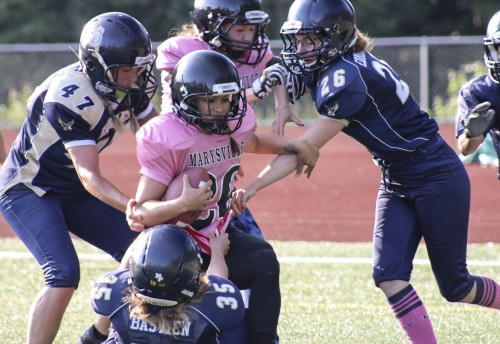
Team organizer Kym Gallo has been playing since the start and is now in her sixth season. She knows it might be strange to see moms suiting up for practice right along with their kids who are running drills on the opposite side of the field, but says the kids think it’s awesome. And the large ticket sales on game day show people are intrigued to see these moms showcase their skills in one of the fastest growing sport across the nation.
Women’s football is becoming a role model for young women by breaking barriers in traditionally assigned gender sports. More and more girls are joining flag and tackle football teams, such as the professional women’s tackle football team, Everett Reign.
“In the first year we struggled just to get 17 women playing. Now we have 31 on our roster.” Gallo credits this appeal to play football to those early women who were brave enough to break the stereotype of football as a male only sport.
Gallo explains other moms in MYFL and women attending game day who caught the flackle bug quickly signed up to join Powderpuff.
“They see us on game day and they want to try it. Our kids are so proud of us; that just helps boost us up. Each one of these women make you want to come back and be around them, not only are we learning football, we are picking each other up. We are a sisterhood,” said Gallo.

Photo/ Tulalip News, Brandi N. Montreuil
This sisterhood is what drew Tulalip tribal member Veronica Iukes, known as “Wreckingball” on the field, who is playing her first season as a Powderpuff.
“I lost my sister almost two years ago and have had a hard time adapting. I feel like I gained 20 more sisters being on this team. We have created a bond. When one of us is having an off day, everyone is there to pick one another up. They are the strongest mammas I know who will go above and beyond for their kids,” said Iukes, who has two daughters who cheer for MYFL and a son who plays football and encouraged her to start playing this year.
Also a newcomer to this year’s season is Tulalip tribal member Yvonne Williams whose son has played with MYFL for the past six years. Although interested in joining she was unable to find the time until now.
“When suiting up with full gear it’s game time, whether we are in a game or getting in a good practice. We get a glimpse of what our kids do on the field. The real MVPs are these amazing kids,” said Williams.
“These women are doing what mom’s do best, working hard for their kids. I know some younger girls that can’t wait to play for our team,” continued Williams, who hopes her daughter will join her on the field some day.
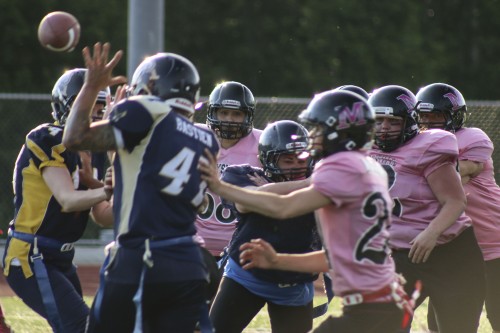
While the idea of women playing football is still a new concept it has gained popularity as women athletes challenge stereotypes.
“We break the stereotype just by looking at us,” said Hernandez. “We are all different ages and sizes in full gear. We are more than just a bunch of moms. This is a sisterhood. We all want to see each other do our best so it’s a constant stream of encouragement, positivity and helping each other get stronger and better. It’s really quite amazing.”
“I would strongly recommend and encourage all mother, aunts, sisters and guardians of children who participate in MYFL or Marysville Junior Cheer Association to play,” said Clarissa Young-Weiser who played with the team last year. “You have a better understanding of the sport and what your child has to go through when playing. There is no other intensity like football.” An injury this season is preventing Young-Weiser from playing this year. She hopes to return the following season.
Marysville Powderpuff team plays their first game on June 26 at 7 p.m. at the Quil Ceda Stadium at Marysville-Pilchuck High School. You can check out their Facebook page at Marysville Powderpuff Football for more information on tickets and team updates.
Brandi N. Montreuil: 360-913-5402; bmontreuil@tulalipnews.com

Photo courtesy of Yvonne Williams
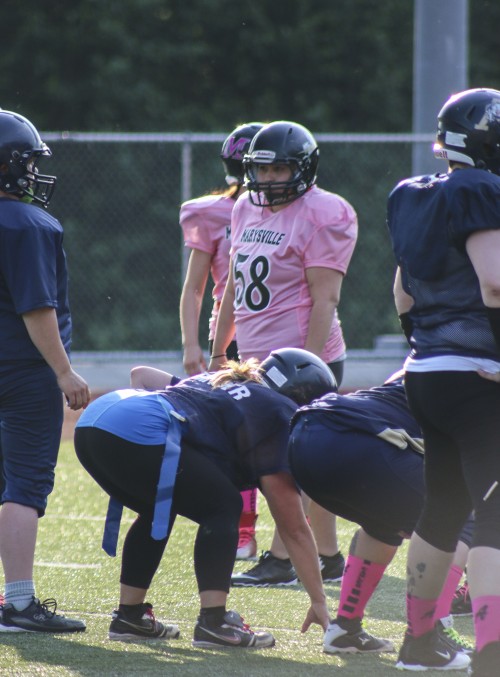
Photo/ Tulalip News, Brandi N. Montreuil
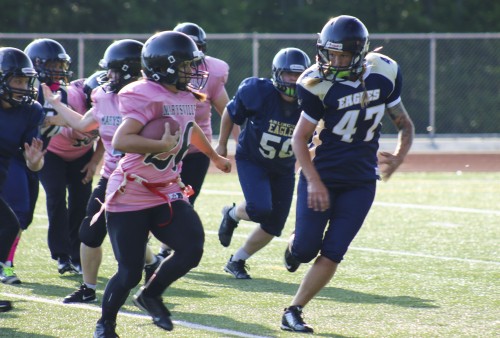
Photo/ Tulalip News, Brandi N. Montreuil

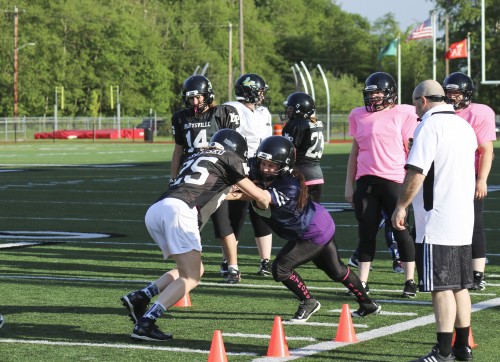
Photo/ Tulalip News, Brandi N. Montreuil

Photo/ Tulalip News, Brandi N. Montreuil
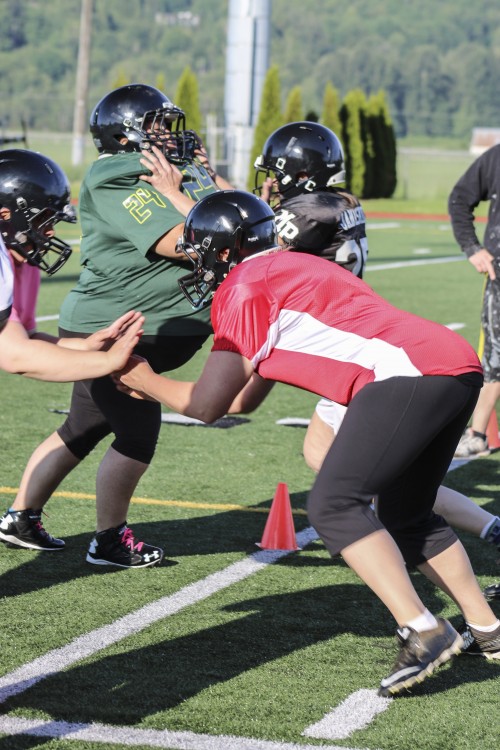
Photo/ Tulalip News, Brandi N. Montreuil
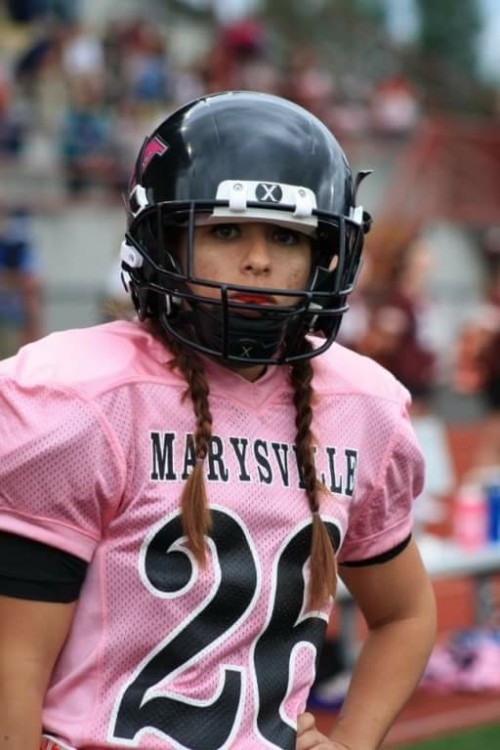
Courtesy of Mytyl Hernandez
Community receives fresh harvest from Wisdom Warrior produce stand
by Micheal Rios, Tulalip News
From 9:00 a.m. – 3:00 p.m. on Friday, May 29, Tulalip community volunteers teamed up with the Wisdom Warriors to participate in the Tulalip Health Clinic’s second ‘Grow your own fruits, vegetables and edible flowers’ community event. The volunteers came together at the Tulalip Bay Wellness Garden and Trail to grow food and community.
The Tulalip Health Clinic’s Diabetes Program is determined to teach the tribal membership how to live a healthy lifestyle that minimizes the risk of diabetes and welcomes any and all community volunteers to become a part of the Wellness Garden. Sponsored by the Diabetes Program, volunteers are provided with seeds, plants, apple trees, blueberry bushes, and raspberry vines among various other fruits and vegetables that are then planted in the Wellness Garden. Master gardeners from Washington State University along with local gardening experts were on hand to answer questions and provide useful gardening tips whenever necessary.
“It’s an opportunity for the people to come back and work with the Earth, their cultural lands and restore it,” says Veronica “Roni” Leahy, Diabetes Program Coordinator of the community gardening events. “The land, this place, is what deserves the recognition. We’re just caretakers and we’re doing what we can to take care of it. Just like we do in the Health Clinic. No different from what we are doing for people on the inside of Health Clinic to restore health, we’re doing the same for people and this land on the outside of the Health Clinic.”
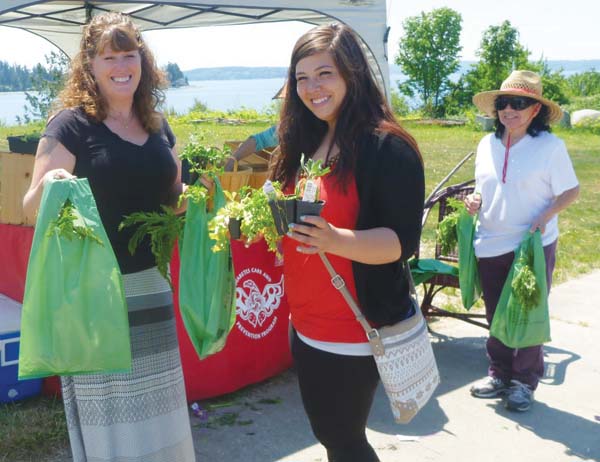
One of the many highlights of the day’s event was the opening of the Wisdom Warrior produce stand. With the assistance of the Diabetes Program, the Wisdom Warriors set up a produce stand on the sidewalk of Totem Beach Road, alongside the Wellness Garden, to give away free organic produce. The purpose of the produce stand is primarily to ensure the produce grown in the Wellness Garden goes out to the community and to give community members a convenient sample to add organic vegetables to their diet
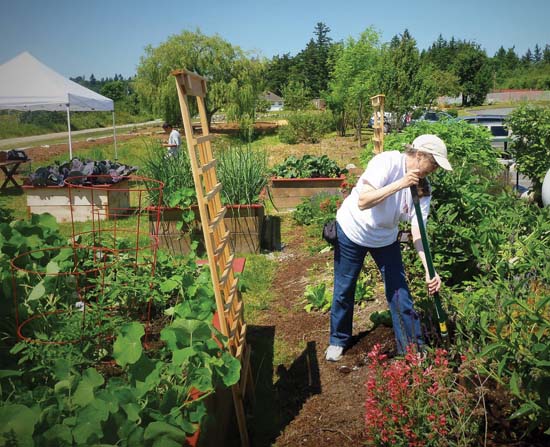
Every person who walked by or drove by and stopped at the produce stand was given a bag of freshly harvested vegetables. Amongst the vegetable bounty were carrots, cucumbers, zucchini, onions, various herbs, kale and lettuce. The kale and lettuce were harvested from the Wellness Garden, while the other vegetables are grown in the Wellness Garden they were not ready to harvest. Instead the not yet ready to harvest vegetables were purchased locally to demonstrate what vegetables are currently being grown.
The Wisdom Warriors estimate they gave away 60+ bags of fresh organic produce to community members.

Contact Micheal Rios, mrios@tualiptribes-nsn.gov
The royal spotlight: Strawberry Festival Queen and King crowned
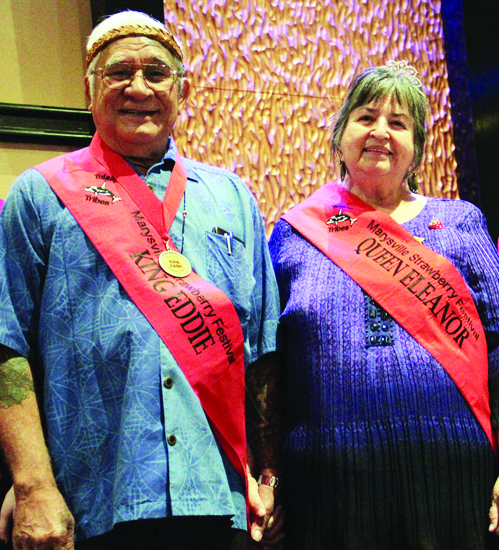
Photo/Mara Hill
by Mara Hill, Tulalip News
Guests travel from all over to participate in the fun and excitement of the annual Elders Luncheon held at Tulalip. For over eighteen years, the Tulalip Tribes has been hosting these luncheons specifically put together to honor elders and seniors. This year it was hosted on May 28 at the Tulalip Tribes Resort and Casino in the Orca Ballroom. Tribal and non-tribal members from our community and surrounding communities come together, find old friends, visit with family and meet new people.
Not only was this Elders Luncheon a day to honor our elders and seniors, it was also a day to crown the King and Queen for our upcoming Strawberry Festival and parade. Each year at least one Tulalip tribal elder is chosen to represent the Tulalip Tribes and the senior community. This year Eleanor Nielsen, a Tulalip tribal member, and her husband Eddie were crowned by the Marysville Strawberry Festival Senior and Junior Royalty.
Eleanor said that she is “proud to be a member of the Tulalip Tribes and to be chosen Queen, representing Tulalip and the Marysville Strawberry Festival.”
Eleanor and Eddie have attended the elders luncheons many times. “It is good to be with family and friends from many tribes. We like sharing the day with everyone,” said Eleanor.
“I am happy to be in the parade and thankful to Tulalip Tribes”, said Eddie.

Photo/Mara Hill
The luncheon included a raffle, which totaled $1500 in cash prize giveaways. There were ten $100 winners and ten $50 dollar winners along with several others who received gift baskets that were donated by tribal departments. In addition to the raffles, students from Tulalip Heritage High School honored the elders and seniors by gifting a blanket to the eldest member at each table.
Tina Brown, Athletic Coordinator at Heritage said “I have been bringing students the past five years to help honor our elders from all over the different reservations and tribes.”
Local and non-local vendors were on hand selling Native crafts and food. Some of the artwork included authentic handmade cedar weaved baskets made by Tulalip Tribal veteran, David Fryberg Sr. Fryberg has been cedar weaving for about 10-15 years and has been vending for approximately 20 years.
Vendors Percy and Ida Kanesta, a couple from Tacoma, have been selling their authentic handmade Native Zuni jewelry at the elder luncheons for almost 15 years and have been hand-making family oriented jewelry for nearly 50 years. Some of the jewelry they make is created out of turquoise, black onyx, silver, lapis, and malachite.
Jimi Pablo a Tulalip tribal member is a first-time vendor at the luncheon but has been in the vending business over 34 years. Pablo was selling fresh, handmade yeast bread. He explained that he had started making the bread at 4:30 p.m. the day before the luncheon and didn’t finish until 4:30 a.m. that day.
Wrapping up the 50’s inspired event were rounds of singing and possibly even a poodle skirt twirl or two.
Contact Mara Hill, mward@tulaliptribes-nsn.gov
